Section 1 Subsystems
Memory -
Memory performance is very important on a motherboard, especially when you have a CPU with multiple cores and threads. If you have slow memory your cores and threads can become starved for data to execute. To test memory performance we run both Sisoft’s SANDRA and AIDA64. These two combine to not only give us accurate numbers but to validate each other. For testing at stock speeds the memory is hard set to 1333MHz while overclocking testing is done at the highest stable speed for the voltage of 1.65v this is due to the different memory dividers for each CPU. As such, the memory speeds will vary greatly. This means that the overclocked numbers are a little misleading and while they can show a trend are really only included to show if a board has a problem with memory performance at high clockspeeds.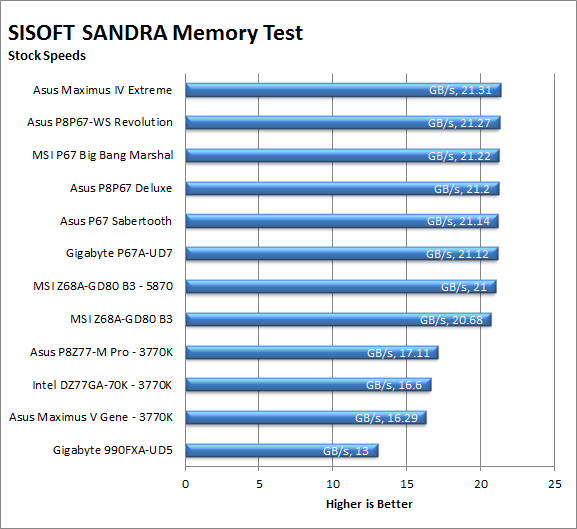
Interestingly the Asus P8Z77-M Pro is at the top of the Z77 motherboards we have tested so far. If this has to do with something in the BIOS or the lack of additional components trying to use system memory we are not sure. Still the overall memory performance of the Ivy Bridge and Z77 combination is a little lower than what we would have thought. Still even with this lower memory bandwidth score we would expect to see solid performance in rendering and transcoding thanks to the new AVX instructions in Ivy Bridge. 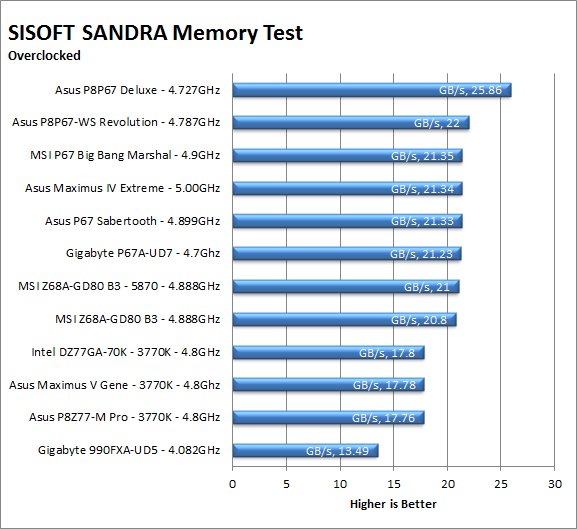
Drive performance -
Drive performance is also one of the major subsystems that goes to make up the performance of a motherboard. For our testing we use Sandra and AIDA64 again. We only test with single drives for each type of controller present on the motherboard (unless it is a professional product where we will use RIAD 5 and/or 10). We have also begun using a Seagate PS-110 USB 3 external HDD and a Kingston HyperX USB 3.0 Flash drive for our USB 3.0 performance. As a side note, we include the overclocked numbers here to make sure (again) that you are not going to see a major drop in performance due to minor instabilities at high clock speeds.
For HDD performance (well ok really SSD performance) we find that the M Pro is faster than Intel’s DZ77GA, but is not as fast as the Maximus V Gene. This is not unexpected as the Gene is a much better put together board (with better components). When we overclocked the M Pro it did pick up where as the Gene lost performance. 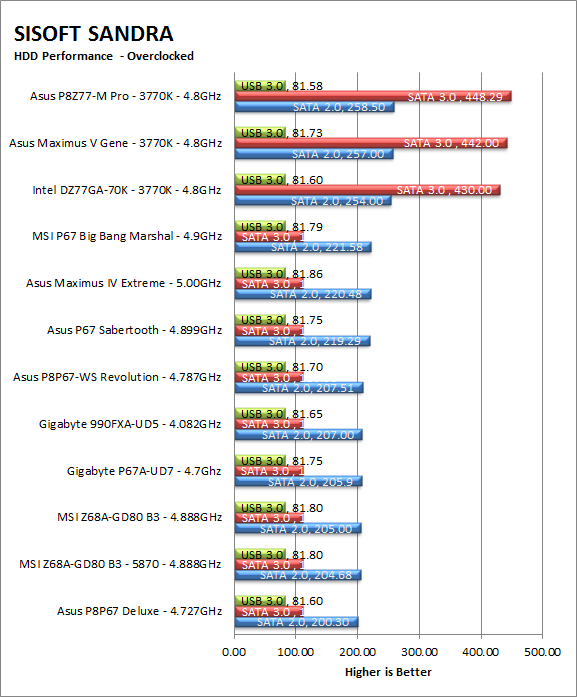
Using the USB 3.0 Boost feature in the Ai Suite II utility we were able to add about 20 additional MB/s with the Kingston HyperX USB 3.0 flash drive we have (from 247.88 to 270.73 on the Intel controller and 245.3 to 268.70 for the ASMedia controller). These are not bad improvements at all. We are still working on a USB 3.0 device that supports the true USAP mode so we can see what this new feature is really capable of.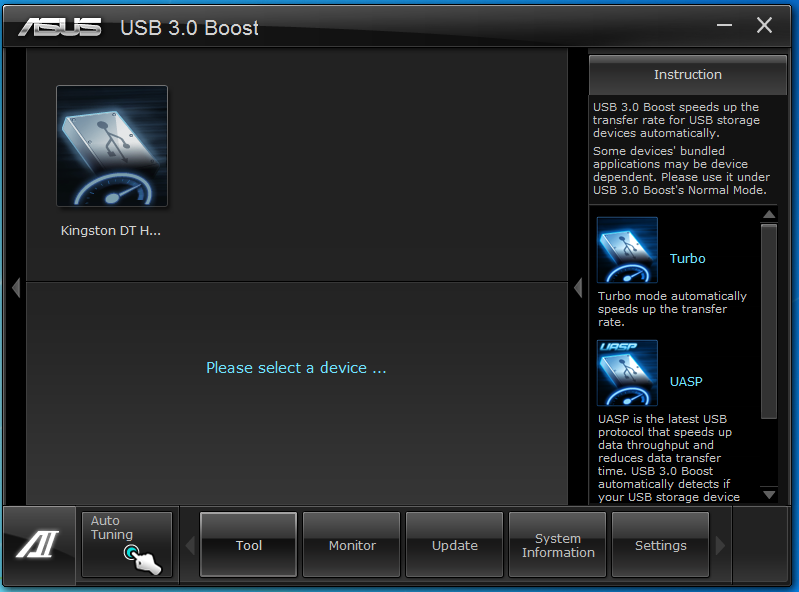
Power -
Power efficiency is another of those misnomers that we get caught up in. We hear about idle states and power gates. But what does that mean to you and I? On the surface having power management that reduces idle power sounds great and can be a benefit to someone that leaves their system on for long periods of time (and inactive) but how a system handles power under load and the delta between the two states is often more important than the idle power usage numbers. We use only P3 Kill A Watt instruments for measuring power. 
The power draw on the P8Z77-M Pro was not bad although it was still at the bottom of the Z77 boards we have tested. This should not be too much of a concern as you can still turn on Asus’ EPU which will help to reduce this quite a bit at idle and with the right profile can even knock some of the power draw back under load. 
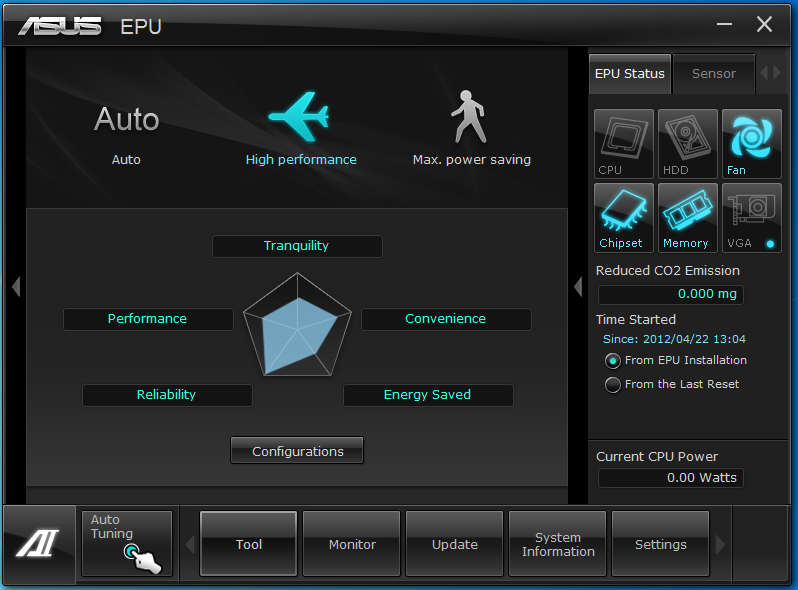
Cooling (Board Level) -
Board level cooling is an important factor in product performance and longevity. Components like the chipset, VRM modules and even capacitors need to be kept relatively cool to prevent failure. As these parts are made of silicon, they have a thermal breakdown threshold; or melting point. At that temperature the actual transistors built into chip will begin to deform and break down. Granted, the threshold is often very high, but you still need to make sure that components stay away from this level of heat for longer product life. 
As we mentioned in our walk around of the board (in the first part of our review) we were concerned about the cooling on the Z77 PCH. It looks like this was a valid concern as we saw some fairly high temperatures. The high level of heat generated could be concerning when it comes to component life and also stability. We would recommend making sure the case you put the P8Z77-M Pro in has plenty of good air flow.- Update- It appears there was an issue with our Fluke 62 Mini. The internal switch that changes the reading from Farenheit to celcius was not working as it should. we have made the calculations to adjust the temps and you can see the results below. We apologize for this as the reading still showed c in the display. However it is obvious that it was not reading properly when we used a second IR thermometer for verification after user comments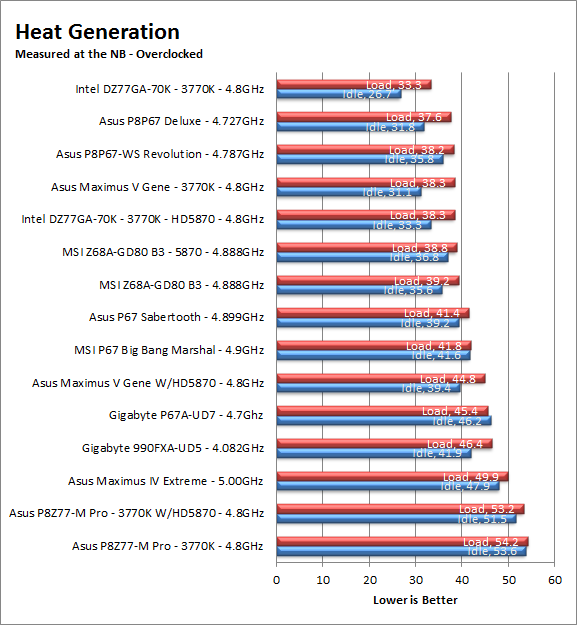
 |
 |
 |
Audio -
Audio is highly subjective. What we find pleasing may sound “off” to you. That is always going to the problem with testing audio; results will vary too widely depending on the tastes of the listener. However, there are ways of measuring the audio output with an objective ear. There is also the issue of audio causing performance issues in gaming and video playback. The reason this is a potential source of concern is that all onboard audio CODECs (Compression/Decompression) are CPU controlled. This means that while the audio chip controls the audio levels and effects of the audio the actual work is done on the CPU. Usually this will not be a problem with today’s powerful CPUs. Even the lower and consumer level products can handle high-end audio these days. But again there is the chance that a bad design or software will hinder your system and performance. On the other side the limits of board space, cost, etc will also prevent the level of audio quality you can get from an add-in board. We test all audio parts with three media types, Movie (DVD), MP3 Music, and Gaming. These are pushed to our Tec On model 55 Tube Amp to see if we can detect any signal issues in the reproduction.

The audio on the P8Z77-M Pro is pretty standard. It is a Realtek ALC892 audio CODEC and has an Asus branded control panel. We actually like this panel much better than the stock one as it is easier to view and also to navigate around.
Networking -
This one is something that is a requirement anymore. If you have a computer, the chances are good (like 99%) that you are also connected to high-speed internet. With this you need a good and solid LAN chip to make sure that your data flows properly out and back. 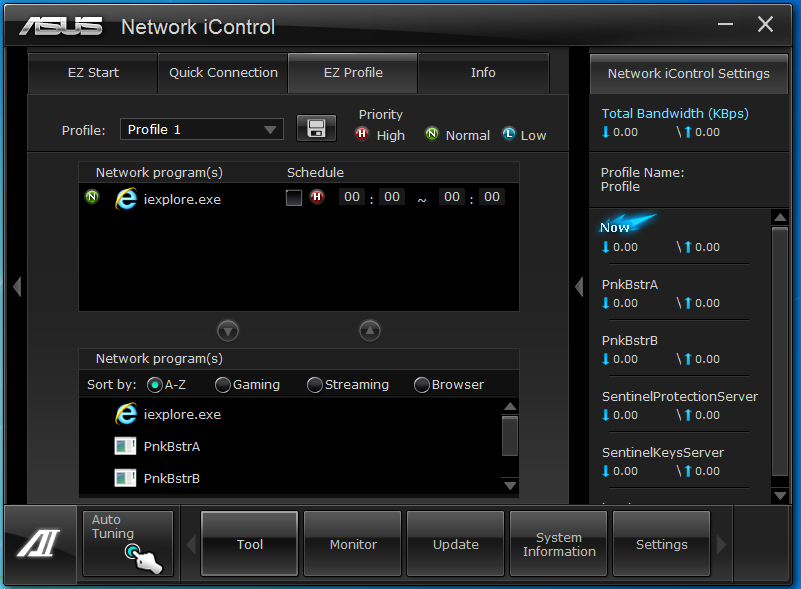
The networking on the P8Z77-M Pro is not an Intel LAN controller like we see on the ROG line and even on the P8Z77-V and –V Deluxe. Here you have a Realtek controller (a Realtek 8111F Gigabit Ethernet controller) which does the job as far as getting your packets back and forth on the network. Asus has added in a nice feature though. It is the Network iControl option. This is a software based Quality of Service utility that is one of the easiest to use that we have seen. To add an application to your QoS profile just highlight it and click on the upward triangle. From there you can set it to normal, low or high priority; very simple.

 At almost the opposite end of the spectrum from the Asus Maximus V Gene (in terms of target market) we find the Asus P8Z77-M Pro motherboard. The P8Z77-M Pro is also a micro ATX board and despite being aimed at the lower end of the consumer market it shares some of the same features that the Gene has. You still get Asus’ Digi+ power controls and FanXpert+ along with Asus’ commitment to solid design and component selection. We have talked about most of these items in
At almost the opposite end of the spectrum from the Asus Maximus V Gene (in terms of target market) we find the Asus P8Z77-M Pro motherboard. The P8Z77-M Pro is also a micro ATX board and despite being aimed at the lower end of the consumer market it shares some of the same features that the Gene has. You still get Asus’ Digi+ power controls and FanXpert+ along with Asus’ commitment to solid design and component selection. We have talked about most of these items in 

